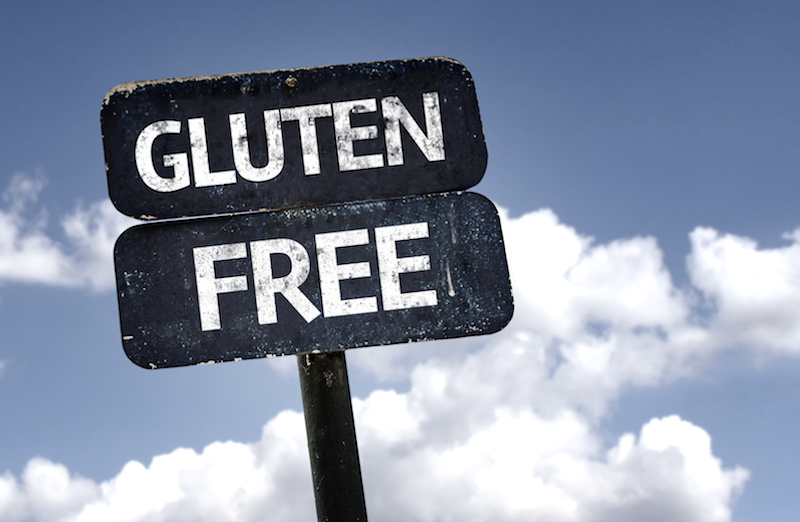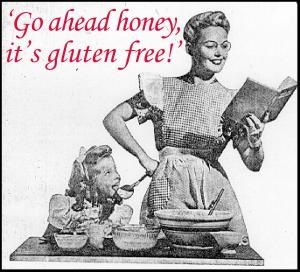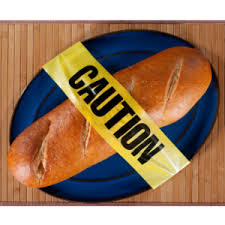Gluten has become a popular topic in the news, do I eat it or do I not? If you are having digestive issues, there’s a good chance that you will benefit from eliminating gluten for a time. That’s not saying you can’t ever have it again! Since my gut is in a much better place, I can handle small amounts of gluten from time to time. (Freshly ground whole wheat and sprouted grains)
Today my friend and fellow Health Coach Jenna over at Healthier Notions is sharing her thoughts on this particular subject.
 Let’s Talk Gluten.
Let’s Talk Gluten.
Gluten is a protein that is found in wheat, rye, kamut, barley, spelt, and some oats. It is formed when the two proteins called Gliadin and Glutenin are combined with water. Gluten is touch and rubbery, and responsible for allowing bread o stretch and rise. Chances are you eat a lot of gluten, as the standard western diet consists of pizza, pasta, bread (to find out what is wrong with supermarket bread click HERE) , and processed foods- all very high in gluten.
Just Another Fad?
I k now it seems like everyone is talking about going “gluten-free” and critics accuse it of being the new “fat-free” fad. And they are not entirely wrong. Food companies have indeed taken this opportunity to shell out tons of processed, sugary, crap food that are marketed as “gluten-free”.
now it seems like everyone is talking about going “gluten-free” and critics accuse it of being the new “fat-free” fad. And they are not entirely wrong. Food companies have indeed taken this opportunity to shell out tons of processed, sugary, crap food that are marketed as “gluten-free”.
Don’t buy into it, folks. If you want to live a gluten-free lifestyle, stick to real, whole foods. If you do this you can’t lose.
I have personally found so much success with being gluten-free. It wasn’t until I made this switch that I ditched the extra five-ten stubborn pounds, my brain fog hit the road, and my recurring rash completely disappeared.
So although being gluten-free can seem like the newest fad, this is much more serious than just a quick diet to lose weight. But if weight gain is your goal, eating gluten will sure get you there quickly.
Why Gluten Can Be Harmful:
Gluten intolerance and sensitivity affects millions of Americans, most of whom are unaware. These people complain of bloating, migraines, an inability to lose weight, irritable bowel syndrome, constipation, rashes, and more. Many times this is simply an allergic reaction to gluten.
According to a review in The New England Journal of Medicine, there are 55 diseases that can be caused by eating gluten. (i) These include irritable bowel syndrome, cancer, osteoporosis, rheumatoid arthritis, lupus, multiple sclerosis, and almost all other autoimmune diseases. Gluten is also linked to anxiety, depression, (ii) schizophrenia, dementia, as well as autism. (iii)
Gluten is problematic for people with celiac disease, and for those with gluten sensitivities. Celiac disease is the most extreme, affecting an estimated three million Americans. (iv) A person with celiac disease is completely gluten intolerant and must eliminate gluten entirely from their diet.
The only way to find out if you have celiac disease is to get tested. The blood test is about 95% accurate, and it’s advised to get a biopsy to confirm. An important fact to remember is that you must be eating gluten for the test to be accurate. The removal of gluten for people with celiac disease must be a habit maintained for life.
Gluten is also detrimental to those with gluten sensitivity. It’s estimated that one-third of the American population is gluten sensitive. These people include those who have tested negative for celiac disease but have relief from problematic symptoms when gluten is avoided.
If you suffer from bloating, irritable bowel syndrome, rashes, joint pain, arthritis, depression, anxiety, migraines, constipation, or the inability to lose weight, I encourage you to go at least ten days without gluten to see if it could be the cause.
So What Are My Alternatives?
Your options are really limitless on this one! There are so many naturally gluten-free foods that are full of fiber and other beneficial vitamins and minerals.
Naturally Gluten-Free Foods:
- brown rice
- millet
- kasha
- gluten-free oats
- quinoa
- fruits
- vegetables
- nuts/seeds
- beans
- most dairy
- eggs
- fish, poultry, meat
- herbs
Beware of:
-Barley labeled under malt, malt flavoring, malt vinegar, and brewer’s yeast.
– distilled vinegar
-soy sauce
Once again, remember to be a label detective. It’s very easy for gluten to hide in processed items and condiments, so the more you stick to real, whole foods, the easier it will be to avoid.
Happy to be Gluten-Free,
Health Coach Jenna

Jenna Longoria is a traveling yoga teacher and certified holistic health coach. She loves Ashtanga yoga, vegan cuisine, and could drink her weight in cold-pressed green juice. You can read more of her work on her website, Healthier Notions. Follow her on Twitter and Facebook!









 Let’s Talk Gluten.
Let’s Talk Gluten. now it seems like everyone is talking about going “gluten-free” and critics accuse it of being the new “fat-free” fad. And they are not entirely wrong. Food companies have indeed taken this opportunity to shell out tons of processed, sugary, crap food that are marketed as “gluten-free”.
now it seems like everyone is talking about going “gluten-free” and critics accuse it of being the new “fat-free” fad. And they are not entirely wrong. Food companies have indeed taken this opportunity to shell out tons of processed, sugary, crap food that are marketed as “gluten-free”. 

